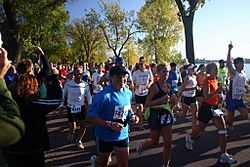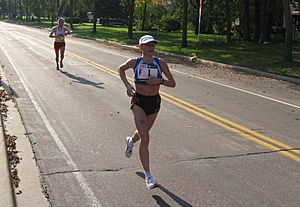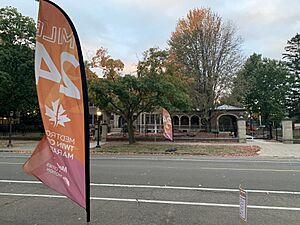Twin Cities Marathon facts for kids
The Twin Cities Marathon is a big running race in Minneapolis and St. Paul, USA. It happens every year in early October. Many people call it "The Most Beautiful Urban Marathon in America." This is because the running path goes through city areas, past lakes, and through pretty tree-lined neighborhoods.
The first Twin Cities Marathon happened on October 3, 1982. Before that, Minneapolis and St. Paul had their own separate marathon races. The very first race that led to this marathon was called the Land of Lakes Marathon, which started in 1963.
The Twin Cities Marathon is one of the top 10 biggest marathons in the United States. In 2006, a company called Medtronic became a main sponsor. Because of this, the race's official name changed to Medtronic Twin Cities Marathon (MTCM).
The MTCM is now a whole weekend of events. There are races for runners and people in wheelchairs of all ages. On Sunday, adults can run the marathon or the Medtronic TC 10 Mile race. On Saturday, there are Medtronic TC Family Events for kids and adults. These include the TC 10K, TC 5K, Diana Pierce Family Mile, Toddler Trot, Diaper Dash, and Mascot Invitational. Thousands of volunteers help make these events happen every year.
Contents
How the Marathon Started
The very first race that led to the Twin Cities Marathon was called the Land of Lakes Marathon. It started in 1963. Only five men ran that first race, and just three finished the 26.2-mile course. In 1973, about 80 runners completed the Land of Lakes Marathon.
In 1976, the race changed its name to the City of Lakes Marathon. It moved to a course that went around two lakes, Bde Maka Ska and Lake Harriet. By 1981, many people wanted to run, and the race filled up quickly with 1,700 runners.
At the same time, St. Paul started its own marathon in 1981. About 2,000 runners joined that first St. Paul Marathon.
In 1982, the people who organized the St. Paul and City of Lakes marathons decided to work together. They wanted to create one big marathon that connected both Minneapolis and St. Paul. They thought it would be a much bigger and better race.
The first Twin Cities Marathon in 1982 had 4,563 runners. This was a record for a new race in the United States. About 100,000 people came to watch the runners. The race originally started near the Pillsbury Center building in Minneapolis. It finished at Town Square in St. Paul.
In 1986, a company called Pillsbury promised to give more money for prizes. This made the Twin Cities Marathon one of the best marathons in the fall season.
In 1990, the starting line for the marathon moved to the Metrodome stadium. This change happened because Pillsbury was no longer a sponsor. It also helped the race follow rules for marathon courses.
In 1998, the Twin Cities Marathon started using ChampionChip timing chips. These chips helped get more accurate times for all the runners.
In 2004, a runner named Irina Permitina finished first for the women. Her time was so close to the record that it ended up being a tie with the previous record set in 2001.
In 2007, the Twin Cities Marathon began hosting special USATF championships. This means that the 10-mile race and the marathon itself have been chosen as national championship races for American runners. When this happens, the prize money is bigger, and more top runners come to compete.
In 2016, the Metrodome stadium was taken down. A new stadium, U.S. Bank Stadium, was built in its place. This meant runners could no longer use the stadium to stay warm or use bathrooms before the race.
In 2017, for the first time, more people signed up for the 10-mile race than for the full marathon.
The Twin Cities Marathon added a special division for non-binary runners in 2019. This was earlier than many other big marathons like New York City or Boston. By 2023, a record 52 non-binary runners took part in the races.
The race was canceled in 2020 because of the COVID-19 pandemic. It was also canceled in 2023 because of very hot and humid weather. After the 2023 cancellation, the organizers looked into moving the race to a different date. However, they decided to keep the date the same, as moving it would not guarantee better weather.
The Race Course
The marathon course starts near U.S. Bank Stadium in downtown Minneapolis. It then goes around several famous lakes in the city. These include Lake of the Isles, Bde Maka Ska, Lake Harriet, and Lake Nokomis.
After the lakes, the course turns north and follows the Mississippi River for several miles. Then, runners cross into St. Paul. The course goes up Summit Avenue and finishes at the Minnesota State Capitol. The last few miles of the race are uphill, which can be challenging. However, the very last half-mile is downhill, allowing runners to finish strong.
Race Winners
Marathon Winners
Course record
|
|
||||||||||||||||||||||||||||||||||||||||||||||||||||||||||||||||||||||||||||||||||||||||||||||||||||||||||||||||||||||||||||||||||||||||||||||||||||||||||||||||||||||||||||||||||||||||||||||||||||||||||||||||||||||||||||||||||||||||||||||||||||||||||||||||||||||||||||||||||||||||||||||||||||||||||||||||||||||||||||||||||||||||||||||||||||||||||||||||
|
||||||||||||||||
TC 10 Mile Winners
Key: Course record USATF 10 Mile Championship
| Edition | Year | Men's winner | Time (m:s) | Women's winner | Time (m:s) |
|---|---|---|---|---|---|
| 1 | 1999 | 52:01 | 57:13 | ||
| 2 | 2000 | 52:02 | 1:00:17 | ||
| 3 | 2001 | 52:53 | 57:20 | ||
| 4 | 2002 | 51:40 | 55:48 | ||
| 5 | 2003 | 50:46 | 54:28 | ||
| 6 | 2004 | 48:42 | 57:10 | ||
| 7 | 2005 | 50:48 | 55:09 | ||
| 8 | 2006 | 48:54 | 53:51 | ||
| 9 | 2007† | 47:34 | 56:26 | ||
| 10 | 2008‡ | 50:27 | 53:16 | ||
| 11 | 2009† | 46:35 | 57:32 | ||
| 12 | 2010‡ | 50:43 | 54:21 | ||
| 13 | 2011 | 46:46 | 54:15 | ||
| 14 | 2012 | 47:19 | 53:43 | ||
| 15 | 2013 | 49:03 | 58:47 | ||
| 16 | 2014 | 48:12 | 56:27 | ||
| 17 | 2015 | 46:47 | 51:44 | ||
| 18 | 2016 | 47:25 | 52:49 | ||
| 19 | 2017 | 47:33 | 53:43 | ||
| 20 | 2018 | 46:32 | 52:47 | ||
| 21 | 2019 | 46:55 | 53:11 | ||
| - | 2020 | Canceled due to COVID-19 pandemic | |||
| 22 | 2021 | 49:19 | 56:40 | ||
| 23 | 2022 | 49:35 | 54:17 | ||
| - | 2023 | Canceled due to heat and humidity | |||
| 24 | 2024 | 45:13 | 52:29 | ||
† Men's championship only. ‡ Women's championship only
See also
- Grandma's Marathon
- Minneapolis Marathon





